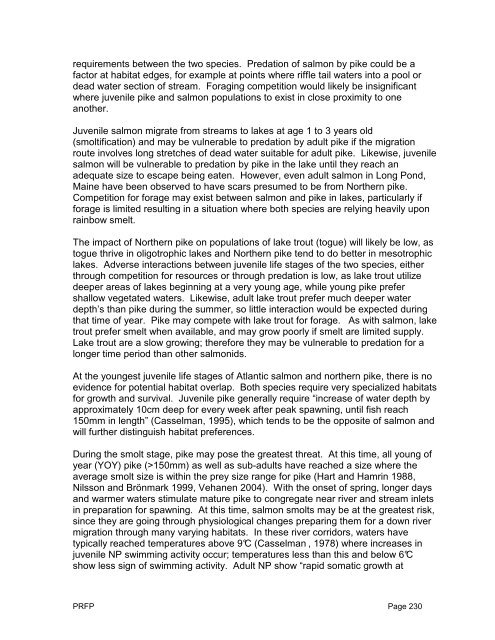Operational Plan for the Restoration of Diadromous Fishes to the ...
Operational Plan for the Restoration of Diadromous Fishes to the ...
Operational Plan for the Restoration of Diadromous Fishes to the ...
Create successful ePaper yourself
Turn your PDF publications into a flip-book with our unique Google optimized e-Paper software.
equirements between <strong>the</strong> two species. Predation <strong>of</strong> salmon by pike could be a<br />
fac<strong>to</strong>r at habitat edges, <strong>for</strong> example at points where riffle tail waters in<strong>to</strong> a pool or<br />
dead water section <strong>of</strong> stream. Foraging competition would likely be insignificant<br />
where juvenile pike and salmon populations <strong>to</strong> exist in close proximity <strong>to</strong> one<br />
ano<strong>the</strong>r.<br />
Juvenile salmon migrate from streams <strong>to</strong> lakes at age 1 <strong>to</strong> 3 years old<br />
(smoltification) and may be vulnerable <strong>to</strong> predation by adult pike if <strong>the</strong> migration<br />
route involves long stretches <strong>of</strong> dead water suitable <strong>for</strong> adult pike. Likewise, juvenile<br />
salmon will be vulnerable <strong>to</strong> predation by pike in <strong>the</strong> lake until <strong>the</strong>y reach an<br />
adequate size <strong>to</strong> escape being eaten. However, even adult salmon in Long Pond,<br />
Maine have been observed <strong>to</strong> have scars presumed <strong>to</strong> be from Nor<strong>the</strong>rn pike.<br />
Competition <strong>for</strong> <strong>for</strong>age may exist between salmon and pike in lakes, particularly if<br />
<strong>for</strong>age is limited resulting in a situation where both species are relying heavily upon<br />
rainbow smelt.<br />
The impact <strong>of</strong> Nor<strong>the</strong>rn pike on populations <strong>of</strong> lake trout (<strong>to</strong>gue) will likely be low, as<br />
<strong>to</strong>gue thrive in oligotrophic lakes and Nor<strong>the</strong>rn pike tend <strong>to</strong> do better in mesotrophic<br />
lakes. Adverse interactions between juvenile life stages <strong>of</strong> <strong>the</strong> two species, ei<strong>the</strong>r<br />
through competition <strong>for</strong> resources or through predation is low, as lake trout utilize<br />
deeper areas <strong>of</strong> lakes beginning at a very young age, while young pike prefer<br />
shallow vegetated waters. Likewise, adult lake trout prefer much deeper water<br />
depth’s than pike during <strong>the</strong> summer, so little interaction would be expected during<br />
that time <strong>of</strong> year. Pike may compete with lake trout <strong>for</strong> <strong>for</strong>age. As with salmon, lake<br />
trout prefer smelt when available, and may grow poorly if smelt are limited supply.<br />
Lake trout are a slow growing; <strong>the</strong>re<strong>for</strong>e <strong>the</strong>y may be vulnerable <strong>to</strong> predation <strong>for</strong> a<br />
longer time period than o<strong>the</strong>r salmonids.<br />
At <strong>the</strong> youngest juvenile life stages <strong>of</strong> Atlantic salmon and nor<strong>the</strong>rn pike, <strong>the</strong>re is no<br />
evidence <strong>for</strong> potential habitat overlap. Both species require very specialized habitats<br />
<strong>for</strong> growth and survival. Juvenile pike generally require “increase <strong>of</strong> water depth by<br />
approximately 10cm deep <strong>for</strong> every week after peak spawning, until fish reach<br />
150mm in length” (Casselman, 1995), which tends <strong>to</strong> be <strong>the</strong> opposite <strong>of</strong> salmon and<br />
will fur<strong>the</strong>r distinguish habitat preferences.<br />
During <strong>the</strong> smolt stage, pike may pose <strong>the</strong> greatest threat. At this time, all young <strong>of</strong><br />
year (YOY) pike (>150mm) as well as sub-adults have reached a size where <strong>the</strong><br />
average smolt size is within <strong>the</strong> prey size range <strong>for</strong> pike (Hart and Hamrin 1988,<br />
Nilsson and Brönmark 1999, Vehanen 2004). With <strong>the</strong> onset <strong>of</strong> spring, longer days<br />
and warmer waters stimulate mature pike <strong>to</strong> congregate near river and stream inlets<br />
in preparation <strong>for</strong> spawning. At this time, salmon smolts may be at <strong>the</strong> greatest risk,<br />
since <strong>the</strong>y are going through physiological changes preparing <strong>the</strong>m <strong>for</strong> a down river<br />
migration through many varying habitats. In <strong>the</strong>se river corridors, waters have<br />
typically reached temperatures above 9°C (Casselman , 1978) where increases in<br />
juvenile NP swimming activity occur; temperatures less than this and below 6°C<br />
show less sign <strong>of</strong> swimming activity. Adult NP show “rapid somatic growth at<br />
PRFP Page 230






